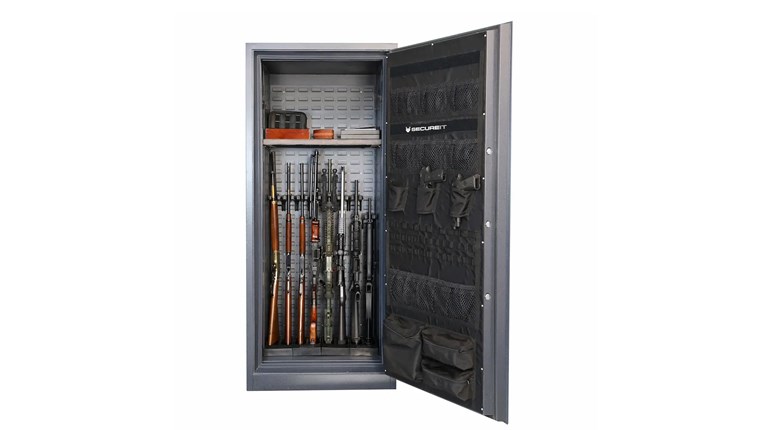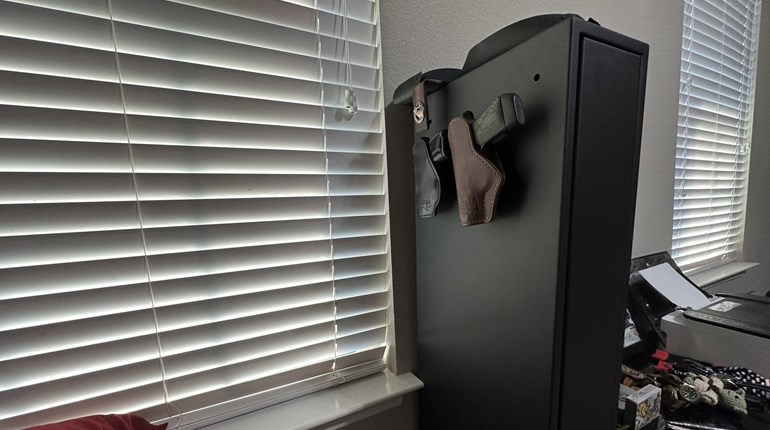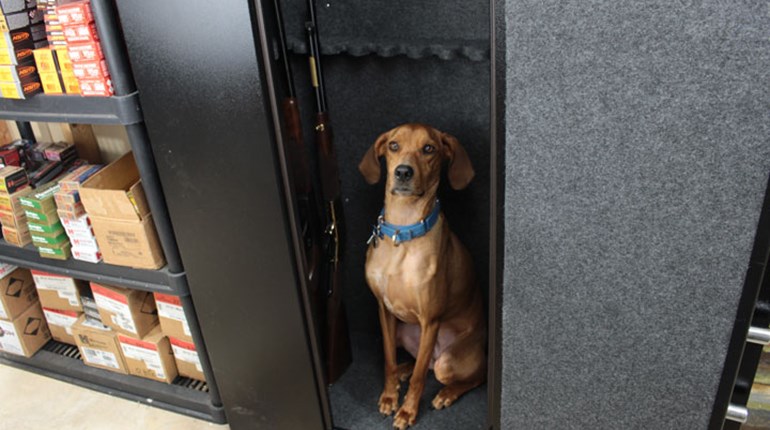
The right to keep and bear arms was guaranteed by our nation’s forefathers, but in today’s litigious society there comes along with it an implied requirement to do so in a responsible manner. Firearms stored irresponsibly are susceptible to fire, theft and unauthorized use that can have tragic consequences.
How we store our firearms when they are not in use, in a safe-and-secure manner, is a personal decision, one determined by your home situation, children’s age, the firearm competency of all the residents and your neighborhood. More than likely the storage method is determined by a combination of all the factors. Any way you look at it though, at some point you may want to consider buying a safe for your firearms and valuables.
Finding the right gun safe can be just as difficult as purchasing a new car. There are many different makes and models, and each has its own features the manufacturer wants you to believe make it the best. In fact, safes today look every bit as nice as a new car and can cost as much as a good used car. So how do you tell the difference between the luxury and economy models in the safe business, and is there such a thing as a bargain safe?
My research leads me to believe that, as with most consumer goods, you get what you pay for. Many of us will not think twice about spending $1,000 on a gun, yet when it comes time to secure our firearms, we are unwilling to spend more than a couple of hundred dollars on a bargain-basement storage cabinet on sale in one of the “big box” stores. Having served many years as a law enforcement officer, three of them as a burglary detective in the mid-1990s, I had an opportunity to see firsthand how easily a safe can be breached. I’ve also had the opportunity to interview and interrogate many who make a living out of preying on unsuspecting home and business owners.
First and foremost, there is no such thing as a burglar-proof or fireproof safe. Given the time and opportunity, a sufficiently motivated individual will eventually force open any safe, including a bank vault. A good safe is designed to deter or prolong an intruder’s ability to gain access to its contents or prolong the integrity of the contents during a fire. Even bank vaults have burglar and fire alarms.
An educated consumer is a wonderful thing and, after all, if you’re going to make this kind of commitment to protect your firearms and valuables, a little education goes a long way. Here are some of the key considerations when looking at a good, quality safe.
Exterior Construction
Safe walls can be constructed from thicknesses of steel that vary from3⁄16 inch to 12-gauge steel. Seven-gauge or 3⁄16-inch steel is .187 inch thick,10-gauge is .135 inch, 11-gauge is.120 inch and 12-gauge is .105 inch.
The thicker the steel, the more difficult and time consuming it will be to breach. Thicker steel also means a heavier safe. Unfortunately, thicker steel also equates to a more expensive safe.
While I have seen safes that weighed more than 1,000 pounds dragged out of a business by just two people, the more difficult you make it to remove a safe from its location, the more likely someone is going to move on to an easier target. Any safe you consider purchasing should come pre-drilled with mounting holes in the bottom for bolting it to the floor. Safes should be secured with lag bolts into concrete anchors or lagged into the floor joists.
Hinges
Exterior hinges allow a door to swing open 180 degrees, providing full access to the interior. Internal door hinges typically cannot allow the door to swing further than 90 to 100 degrees. While this may limit some access to the inside of your safe, internal hinges will prevent the door from opening so far that the spinner knob damages an abutting wall. Internal hinges also need a place to recess into the interior, and therefore could create a “hot spot” in the fire protection.
There is also the argument that exterior hinges provide an opportunity or a weak point for a forcible entry through the door. My experience and research leads me to believe that a safe door equipped with locking bolts that extend beyond the door jamb of all four sides probably isn’t any easier to force open than a door with interior hinges.
Door Construction
A quality gun safe will have bolts along the entire outside perimeter of the door. The bolts come in a variety of sizes, and several of the manufacturers even went so far as to admit a11⁄2-inch bolt really won’t provide more security than a 1-inch diameter bolt, despite the fact their size is usually increased in higher-end safes. Active bolts are the ones operated by the spinner dial or handle on the outside of the door. They should extend a minimum of 1 inch beyond the jamb of the safe opening when fully extended. Dead bolts are typically found on the hinge side of a door. Dead bolts do not retract into the door, but provide door integrity on the hinge side when the door is fully locked.
Look for active locking bolts on a minimum of three sides of the door. Active bolts or dead bolts on the hinge side should also be present. Five active bolts—three on the open side, one on top and another at the bottom—should be the absolute minimum when considering a 60-inch tall safe.
Internal Lock Protection
Because it is the primary access, the untrained, uninitiated or novice often think the door is the weakest part of the safe. Most forced-entry attempts begin there.
That’s why quality gun safes are made with additional safeguards in the door, including a hard plate and relockers. Hard plate is generally an additional layer, sometimes layers, of steel plate hardened to extreme hardness ratings that will dull all but the most expensive carbide drill bits. Some manufacturers go so far as to add a layer of ball bearings to their hard plate for additional protection. If penetrated, the ball bearings begin spinning, stopping the drill’s entry.
A relocker is a device—usually spring loaded—that drops a deadbolt into the door’s locking device during a breach. Once tripped, a locksmith will have to get proprietary information from the safe manufacturer to locate the specific drill points necessary to unlock the bolt group.
UL Certification
Underwriters Laboratories, or UL as it is commonly known, has been in existence since 1894. It tests more than 19,000 types of products, components, materials and systems annually to ensure a product carrying the UL label has the kind of quality customers have grown to expect. It has two different standards by which it rates gun safes. The “Residential Security Container,” standard number 1037, is the yardstick commonly used for most residential gun safes. To receive this rating a manufacturer must submit drawings and all proprietary blueprints and schematics related to the particular model being submitted for testing. UL’s engineers and technicians review the plans, and after careful consideration, attempt to gain entry at the locations deemed most vulnerable. The safe must withstand a five-minute attack. If the door is breached or if the technician can create an opening in one of the five sides large enough for a 4-inch sphere to pass through, the safe fails to receive the UL certification. It is interesting to note only 18 inch or shorter pry bars, hammers less than3 pounds and drills with carbide bits less than 1⁄4 inch in diameter are permitted to be used in this test. The limited testing procedure may not seem realistic, but it’s designed to simulate items found in the average homeowner’s garage or workshop.
Another UL certification you may see, although less frequently, is a “TL” rating. It’s listed under UL standard number 687, and is much more intense because it’s written for commercial safes. A TL-rated safe has been subjected to a variety of more complex tools, for longer periods of time. ATL-30 rating would mean the safe withstood a severe attack for a minimum of 30 active minutes. A TL-30x6 rating means the safe withstood a severe entry attempt for a minimum of 30 active minutes on all 6 sides of the safe. This is 30 minutes per side. The tools permitted to be used for a TL attack are “any common hand tools, high-speed electric drills with carbide bits no larger than 1⁄2 inch, abrasive cutting wheels, power saws, and portable mechanical and electric grinding tools.” Again, even before the UL technicians begin their work, they have already studied the engineering drawings and determined the weakest points. The TL rating is not encountered often in the residential gun-safe business due to the expense of creating a safe capable of withstanding these types of attack. This rating is typically reserved for ATMs and high-security, burglary-resistant safes. Lastly, the great thing about UL is that it follows up certifications with unannounced inspections of the manufacturing facilities to ensure the company is not deviating from the submitted plans.
Fire Ratings
There is no industry standard on fire protection. As such, it is almost impossible to compare a line of safes from one company against another. While I was told there is a UL fire-rating standard, it was written for record-storage safes in commercial applications only.
Most fire protection being used today in gun safes is made from good old-fashioned gypsum board. That’s right, drywall. It provides a very good level of fire protection by virtue of its construction. Gypsum board contains moisture that, when subjected totemperatures above 262 F, keeps the inside of the safe cool by releasing steam. Most safe companies tout the number of gypsum board layers they are using, but again, take into account the construction of the box, how well it seals and steel thickness. One company’s claim of a 90-minute, 1,200 F rating may be with four layers of gypsum board, while another company may claim a 100-minute, 1,250 F rating with only three.
Additionally, several companies use proprietary materials for fire protection. Regardless, don’t get too hung up on the number of layers or someone’s claims. Instead, look for a safe verified by a credible independent laboratory, such as ETL Testing Laboratories. ETL is a third-party company that specializes in providing performance verification services—independently verifying manufacturer claims through a series of testing protocols.
Lastly, be sure the door has a quality fire seal. Many safes are equipped with smoke seals to prevent smoke and chemicals from contaminating your contents, as well as fire seals made out of palusol. When the palusol seal is exposed to temperatures above212 degrees F, it expands to as much as five times its original thickness. Once expanded, it provides a strong positive seal between the door and body, preventing heat damage to the contents.
Locking Mechanisms
What you lock inside your safe is only as secure as the locking device. There are three types of locks on the market today: keyed, combination and the newest of the technologies, biometric. Keyed locks are the easiest to defeat and you will not find a UL-rated gun safe with a keyed lock.
Combination locks come in two varieties, mechanical and electronic. Mechanical locks are typically a spinning dial with 100 numerically incremental lines on the dial allowing for up to a million different combinations. Electronic locks are typically a keypad utilizing the numbers 0 to 9. They too must provide for up to a million different combinations to become UL rated. Mechanical locks come in three UL ratings.
UL Group 1—Approved for government use, considered manipulation proof and have withstood 48 hours of active attack.
UL Group 2M—Approved for ATM use and must withstand a minimum of two active hours of manipulation attack.
UL Group 2—Approved for gunsafes.
The highest-rated mechanical lock is a UL Group 1. Those in this group can even survive attacks by skilled individuals using sophisticated listening equipment. Group 2M-rated locks are approved for use on ATMs and are guaranteed to withstand a minimum of two hours of manipulation by the same skilled individual. UL Group 2 locks found on quality gun safes are rated to withstand a minimum of 15 minutes of manipulation by a skilled individual.
With the 21st century came electronic locks. They are not susceptible to the same type of manipulation that mechanical locks are. As such, the only rating provided by UL is a Type 1. The last of the new technologies available is biometrics. Biometrics uses the unique physical characteristics all human beings possess to verify identity. Fingerprints, iris scans and DNA are all being utilized in the security field today. Biometric locks utilizing the owner’s fingerprints are typically being offered as an option on many gun safes today. Biometric locks offer a quick means to access your safe and don’t require codes or combinations. Due to the technology involved, biometric locking devices are still evolving, can be expensive and as of yet no standards have been developed by any independent testing authority.
The bottom line is that you should not buy a gun safe without a UL-rated Group 2 mechanical (or better) lock or Type 1 electronic lock. If you’re a technology fiend, and are bad with remembering combinations, consider a combination electronic/biometric lock, but as with any electronic device they can go south without warning.
Warranties and Accessories
Warranties say a lot about a company’s confidence in their products. I’ve seen as little as a five-year warranty offered by one company, while others provide lifetime warranties or some variation thereof. Look for a company that will at the very least provide a lifetime warranty for the original owner on fire, burglary and attempts to enter the safe. The better safe companies’ warranties will, upon verification by a police or fire report, pay for a locksmith to come to your home, drill open your safe if necessary, and repair or replace the safe. Again, a safe is probably going to be a one-time purchase for most of us, so make sure you buy from a reputable company that’s been around a while and that thinks enough of its own product to offer this typeof warranty.
Safes come with a whole slew of options. Door pistol storage racks and internal lights are just a couple of necessities, in my opinion. Dehumidifiers, paint jobs, graphics packages, lock options, a choice of interiors and different spinner handles are just a few of the other options available on safes today.
Summary
While it still may be difficult to determine when you’re comparing apples to apples, there are some important things to look for when investing in a gun safe. Look first for a UL Residential Security Container certification. While a TL rating is nice, I only found one gun safe that had a TL rating, and that was American Security. Second, make sure the lock also has a UL Group 2 or Type 1 rating. Digital and biometric systems are cool, but you can anticipate a life expectancy of 10 years from an electronic, while a good quality mechanical will probably last 50 years. Fire ratings may be difficult to compare, but I’m confident most of the safe manufacturers I saw at the SHOT Show were providing quality products. If you really want something to make you sleep better at night, look for the safes that have had independent verification of their fire protection rating. If you live in an urban or suburban area, 30- to 60-minute protection should be just fine. If you live in a rural area, you might want to consider a 90- to 120-minute rating. Lastly, look at warranties. Most likely, you are probably making the only gun-safe purchase of your life. Look for a manufacturer that has been in business for a while and has a lifetime warranty. Better warranties cover break in, attempted break in, fire and locksmith fees where necessary. Some warranties are to the original buyer, while others will transfer.
Big box stores, shopping malls, outlet centers and sporting goods stores are not where you will find these safes. You will typically have to find a dealer in your area, but shop around. Many times gun shows, online or the local classifieds will provide you with an opportunity for a deal. Also, buy as big as you can afford. I know a lot of people with gun safes, and almost every one of us wishes we had bought a bigger one. Plan on what your needs will be five or 10 years from now, not what your needs are right now. A little knowledge goes a long when it comes to making the kind of safe decision that’ll help you sleep a little easier at night.







































